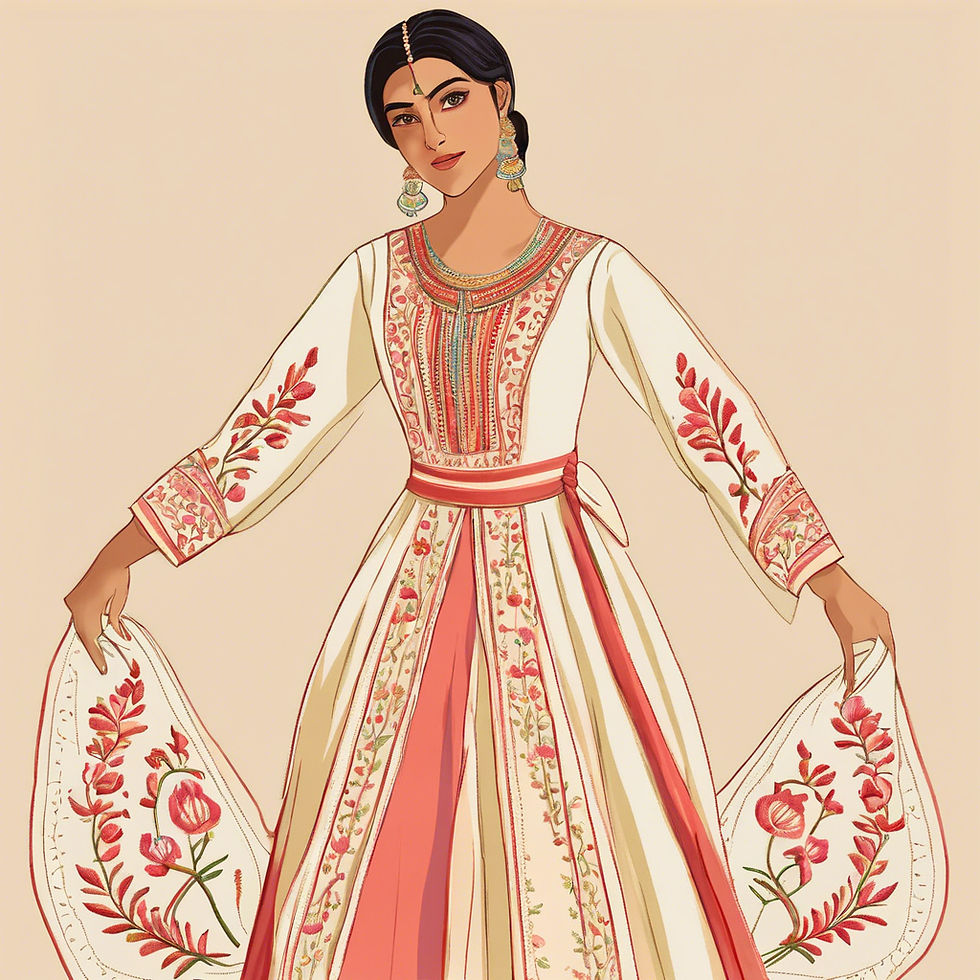What is Aari embroidery?
- Harkesh Kumar
- 1 अक्तू॰ 2024
- 3 मिनट पठन
Aari gets its name from 'Aar', which is a small, hooked needle or awl. The Aari embroidery technique demands an enormous amount of skill, training, patience and precision's
The craftsmen must concentrate on following the fine outlines of the design, while creating the subtle graduations of colour required to filling the motif.
In India, Aari embroidery is a tradition that dates back to the 12th century. This ancient craft began with cobblers in western India, who adapted their hook-needle technique from footwear-making to embroidery. The method gained prominence with the support of the Mughals, becoming a favoured style in garments.
Origins: Aari embroidery was first developed by leather workers to create embellished footwear.
The theory behind Aari work is that it's a type of embroidery that involves using a long needle with a hook to create fine chain stitches on a stretched fabric:
Tools and materials
Aari work requires a wooden frame, called a "khaka", a long needle with a hook, and threads of various thicknesses.
Stitching
The fabric is stretched over the frame and the needle is used to create loops, which are repeated to form a chain stitch.
Embellishments
Aari work is often embellished with sequins, stones, and other decorative elements.
Techniques
Advanced Aari work techniques include shading, layering, and creating three-dimensional elements.
Maintenance
Aari work garments should be dry cleaned but can also be gently hand washed and soft ironed.
Aari work is practiced in various regions of India, including Kashmir and Kutch (Gujarat). It's often used to decorate silk sarees.
Aari embroidery is done by tightening the cloth to be embroidered upon the Khatia (cot) or adda frame and then doing the thread work on portions on the stretched cloth with an Aari or crochet-hook like instrument. The stitch that forms resemble a chain stitch.

Aari embroidery incorporates beads and stones to create a shimmering effect on garments. The placement of these adornments results in a web-like pattern. While Aari embroidery primarily involves thread work, the addition of beads and other embellishments enhances the richness of the design. Its versatility makes it appropriate for any event, as it can adorn a variety of items. Consequently, Aari embroidery appeals to a broad audience. It is utilized to craft intricate designs across the fabric or in specific areas to enhance the item's aesthetic.
Aari embroidery, a traditional craft that combines needle and thread work, has long been revered for its intricate beauty and time-consuming nature. However, with the advent of technological advancements, the process of Aari embroidery has been significantly streamlined, resulting in reduced completion times without compromising on quality.
One of the most notable aspects of Aari embroidery is the mesmerizing patterns it creates on sarees. Women around the world appreciate the detailed and elaborate designs that adorn these traditional garments, adding a touch of sophistication and elegance to their attire.
While sarees are the primary canvas for Aari embroidery, blouses are often left unembellished to allow the focus to remain on the intricate work of the saree. This contrast creates a harmonious balance in the overall look, showcasing the craftsmanship of the embroidery.
When it comes to Kurtas, Aari embroidery is strategically placed on the bodice and edges, enhancing the garment's aesthetic appeal and adding a touch of glamour. The delicate and precise stitches elevate the beauty of the Kurtas, making them stand out in a crowd.
Moreover, Aari embroidery is not limited to clothing items but is also extended to accessories like dupattas. The addition of Aari embroidery to dupattas imparts a sense of grace and charm, transforming a simple accessory into a statement piece that complements any outfit.
Acknowledging its 'all-season' appeal, the demand for this fabric has risen globally.
Furthermore, the versatility of this fabric has made it a favorite among fashion designers worldwide, who are incorporating it into their collections for various seasons and occasions.
Aari embroidery, a traditional Indian handcraft known for its intricate beauty, has recently caught the eye of Western markets. This newfound appreciation has resulted in a significant surge in sales and popularity for Aari-embellished garments.
As the demand for Aari garments grows, global markets are expanding their business by establishing partnerships with Indian artisans and manufacturers. This collaboration not only boosts sales in India but also promotes cultural exchange and sustainable practices in the fashion industry.



Comentarios